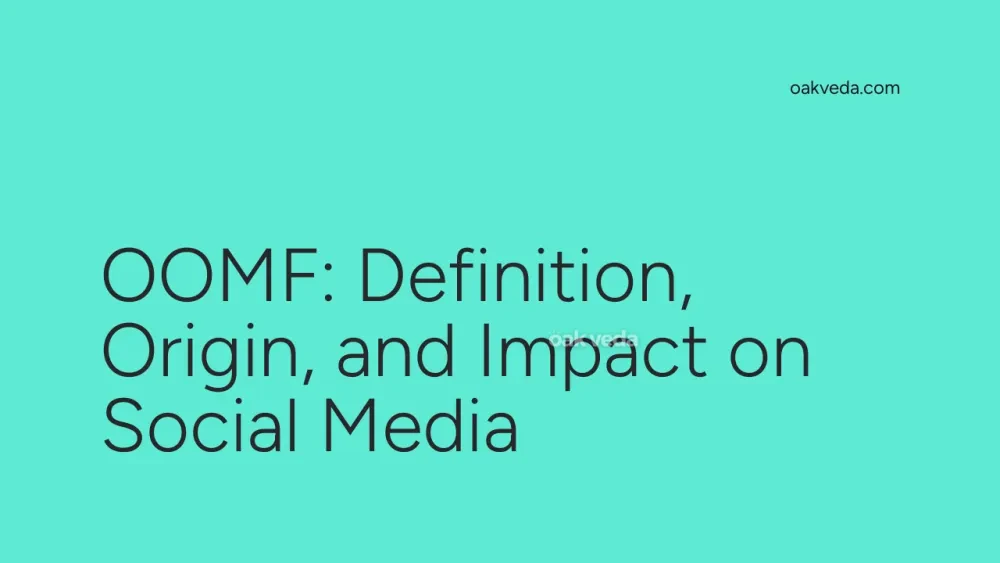
What is OOMF?
OOMF is a popular social media acronym that stands for "One of My Followers." This term has become an integral part of online communication, particularly on platforms like Twitter and Instagram. OOMF is used as a discreet way to refer to someone in your follower list without directly mentioning their name or handle, maintaining privacy and sometimes adding an element of mystery to conversations.
Origin and Development of OOMF
The exact origin of OOMF is difficult to pinpoint, but it gained significant traction in the early 2010s as social media platforms, especially Twitter, became more popular. As users sought ways to communicate more efficiently within character limits and maintain privacy, acronyms like OOMF emerged as a solution. Over time, it has evolved from a simple abbreviation to a cultural phenomenon in the social media landscape.
How OOMF Works
OOMF functions as a versatile tool in social media communication. Here's how it typically works:
- Subtweeting: Users often employ OOMF when talking about someone indirectly, a practice known as subtweeting.
- Privacy preservation: It allows users to discuss or reference a follower without exposing their identity.
- Creating intrigue: The ambiguity of OOMF can spark curiosity among other followers.
- Casual referencing: It's a more informal way to mention someone compared to using their actual handle.
Popular Examples of OOMF
To better understand how OOMF is used in real-world scenarios, let's look at some examples:
- "Can't believe OOMF doesn't like pineapple on pizza. 🍍🍕"
- "Shoutout to #OOMF for always supporting my art! 🎨"
- "Which OOMF wants to join me for a coffee date? ☕"
- "OOMF just dropped the hottest mixtape of the year! 🔥🎵"
These examples demonstrate how OOMF can be used for various purposes, from expressing opinions to giving compliments or making invitations.
Impact of OOMF on Social Media Culture
OOMF has significantly influenced social media culture in several ways:
- Enhanced privacy: It allows users to discuss others without directly involving them, reducing potential conflicts.
- Increased engagement: The mystery behind OOMF often encourages followers to engage more, trying to figure out who is being referenced.
- Subtlety in communication: OOMF has contributed to a more nuanced form of online interaction, where users can express thoughts or feelings indirectly.
- Community building: The term creates a sense of insider knowledge among a user's followers, fostering a closer-knit online community.
Controversies Surrounding OOMF
While OOMF is widely used, it's not without controversy:
- Passive-aggressiveness: Some critics argue that OOMF can be used as a tool for indirect confrontation or gossip.
- Exclusion: The term might make some followers feel left out if they can't decipher who is being referenced.
- Misinterpretation: The ambiguity of OOMF can lead to misunderstandings or false assumptions.
How Brands and Influencers Use OOMF
Savvy brands and influencers have found creative ways to leverage OOMF in their social media strategies:
- Engagement boosting: Brands might use OOMF to create curiosity and encourage follower interaction.
- Teasing collaborations: Influencers often use OOMF when hinting at upcoming partnerships without revealing specifics.
- Customer appreciation: Companies can use OOMF to give shoutouts to customers without compromising their privacy.
- Content creation: OOMF can be used as a prompt for user-generated content, asking followers to guess who is being referenced.
Future Trends Related to OOMF
As social media continues to evolve, so too will the use of OOMF:
- Integration with AI: Future AI-powered social media tools might be able to decipher OOMF references, offering users insights into who is being discussed.
- Evolution of privacy features: Platforms may develop features that allow for more nuanced private referencing, inspired by the popularity of OOMF.
- Cross-platform use: As users become more interconnected across various social media platforms, OOMF might evolve to reference followers from multiple networks.
FAQs about OOMF
-
Is OOMF only used on Twitter? While OOMF originated and is most commonly used on Twitter, it has spread to other platforms like Instagram and TikTok.
-
Can OOMF be used in plural form? Yes, users sometimes use "OOMFs" to refer to multiple followers.
-
Is using OOMF considered rude? It depends on the context. While it can be used harmlessly, some may perceive it as gossipy or passive-aggressive if used negatively.
-
How do you pronounce OOMF? OOMF is typically pronounced as individual letters: "O-O-M-F" or sometimes as a word that rhymes with "oomph."
-
Are there any alternatives to OOMF? Yes, some users prefer more specific terms like "mutuals" (for mutual followers) or simply "a follower."
In conclusion, OOMF has become a significant part of social media lexicon, offering users a unique way to communicate about their followers. While it presents some challenges, its popularity and versatility ensure that OOMF will continue to play a role in shaping online interactions for the foreseeable future. As social media evolves, so too will the ways in which users and brands leverage this intriguing acronym.
You may be interested in:
- Retweet: Definition, Origin, and Impact on Social Media
- Ick: Definition, Origin, and Impact on Social Media Culture
- Retargeting: Definition, Origin, and Impact on Social Media
- Innit: Definition, Origin, and Impact on Social Media
- AI in Social Media: Definition, Origin, and Impact
- Stan: Definition, Origin, and Impact on Social Media Culture

